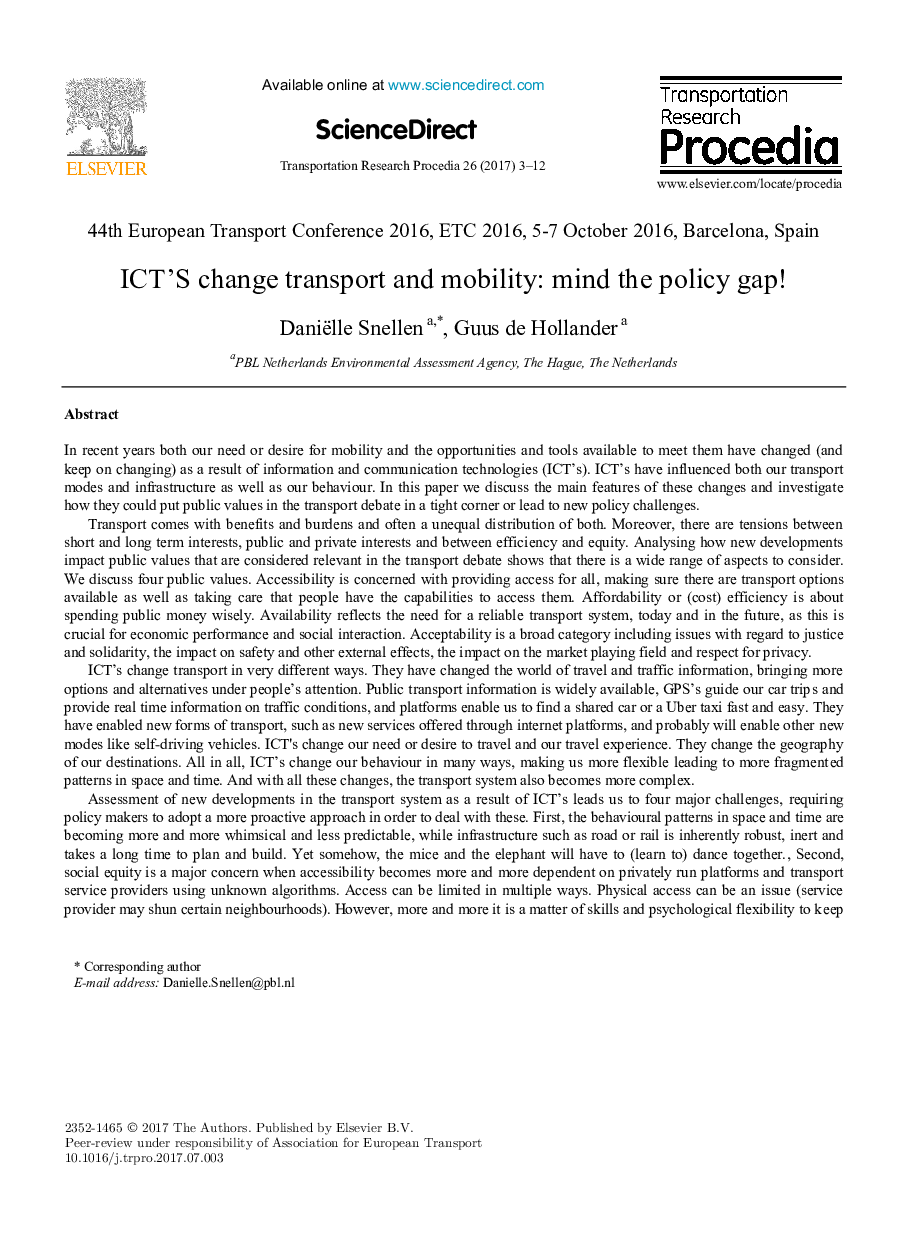| کد مقاله | کد نشریه | سال انتشار | مقاله انگلیسی | نسخه تمام متن |
|---|---|---|---|---|
| 5124996 | 1488269 | 2017 | 10 صفحه PDF | دانلود رایگان |
In recent years both our need or desire for mobility and the opportunities and tools available to meet them have changed (and keep on changing) as a result of information and communication technologies (ICT's). ICT's have influenced both our transport modes and infrastructure as well as our behaviour. In this paper we discuss the main features of these changes and investigate how they could put public values in the transport debate in a tight corner or lead to new policy challenges.Transport comes with benefits and burdens and often a unequal distribution of both. Moreover, there are tensions between short and long term interests, public and private interests and between efficiency and equity. Analysing how new developments impact public values that are considered relevant in the transport debate shows that there is a wide range of aspects to consider. We discuss four public values. Accessibility is concerned with providing access for all, making sure there are transport options available as well as taking care that people have the capabilities to access them. Affordability or (cost) efficiency is about spending public money wisely. Availability reflects the need for a reliable transport system, today and in the future, as this is crucial for economic performance and social interaction. Acceptability is a broad category including issues with regard to justice and solidarity, the impact on safety and other external effects, the impact on the market playing field and respect for privacy.ICT's change transport in very different ways. They have changed the world of travel and traffic information, bringing more options and alternatives under people's attention. Public transport information is widely available, GPS's guide our car trips and provide real time information on traffic conditions, and platforms enable us to find a shared car or a Uber taxi fast and easy. They have enabled new forms of transport, such as new services offered through internet platforms, and probably will enable other new modes like self-driving vehicles. ICT's change our need or desire to travel and our travel experience. They change the geography of our destinations. All in all, ICT's change our behaviour in many ways, making us more flexible leading to more fragmented patterns in space and time. And with all these changes, the transport system also becomes more complex.Assessment of new developments in the transport system as a result of ICT's leads us to four major challenges, requiring policy makers to adopt a more proactive approach in order to deal with these. First, the behavioural patterns in space and time are becoming more and more whimsical and less predictable, while infrastructure such as road or rail is inherently robust, inert and takes a long time to plan and build. Yet somehow, the mice and the elephant will have to (learn to) dance together., Second, social equity is a major concern when accessibility becomes more and more dependent on privately run platforms and transport service providers using unknown algorithms. Access can be limited in multiple ways. Physical access can be an issue (service provider may shun certain neighbourhoods). However, more and more it is a matter of skills and psychological flexibility to keep up with new things (for example smart ticketing in public transport or using apps for travel information) and not everyone can cope with that. Third, there appears to be a strong 'winner-takes-it-all' tendency in the ICT sector. Tech companies become rich, powerful and unassailable, while they profit from collectively financed infrastructure (e.g. Uber). The costs for development, maintenance, education, safety etcetera are left to the public domain, as are the consequences of monopolisation, unfair competition and loss of innovation power. The question is how to price public goods and external effects properly. And fourth, robots and algorithms are quickly becoming independent actors in the transport system, while our rules and regulations are primarily made for humans and organisations. We need to think about requirements for (self-learning) software and robots such as self-driving vehicles, reflecting what moral choices we prefer in critical situations, what we want them to do for us and what not and how to deal with the liability issues that arise.
Journal: Transportation Research Procedia - Volume 26, 2017, Pages 3-12
